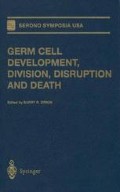Abstract
Several lines of evidence indicate that highly specialized transcriptional mechanisms ensure stringent stage-specific gene expression in the germ cells. Specific checkpoints correspond to the activation of transcription factors; these regulate gene promoters with a restricted pattern of activity, in a germ cell-specific fashion. There is also evidence that general transcription factors may be differentially regulated in germ cells. For example, TBP (TATA-binding protein) accumulates in early haploid germ cells at much higher levels than in any other somatic cell type. It has been calculated that adult spleen and liver cells contain 0.7 and 2.3 molecules of TBP mRNA per haploid genome-equivalent, respectively, while adult testis contain 80–200 molecules of TBP transcript per haploid genome-equivalent (1). In addition to TBP, TFIIB and RNA polymerase II also were found to be overexpressed in the testis (1). These remarkable features are consistent with the potent transcriptional activity that occurs in a coordinated manner during the germ cell differentiation. Here we discuss the characteristics of cAMP-responsive element modulator (CREM) (2), a transcription factor responsive to the cAMP signaling pathway and whose function is crucial for a normal germ cell differentiation program.
Access this chapter
Tax calculation will be finalised at checkout
Purchases are for personal use only
Preview
Unable to display preview. Download preview PDF.
References
Sassone-Corsi P. Transcriptional checkpoints determining the fate of male germ cells. Cell 1997;88:163–6.
Sassone-Corsi P. Transcription factors responsive to cAMP Annu Rev Cell Dev Biol 1995;11:355–77.
McKnight SG, Clegg CH, Uhler MD, Chrivia JC, Cadd GG, Correll LA, et al. Analysis of the cAMP-dependent protein kinase system using molecular genetic approaches. Recent Prog Horm Res 1988;44:307–35.
Montmayeur JP, Borrelli E. Transcription mediated by a cAMP-responsive promoter element is reduced upon activation of dopamine D2 receptors. Proc Natl Acad Sci USA 1991;88:3135–9.
Hoeffler JP, Meyer TE, Yun Y, Jameson JL, Habener JF. Cyclic AMP responsive DNA-binding protein: structure based on a cloned placental cDNA. Science 1988;242: 1430–3.
Hai TY, Liu F, Coukos WJ, Green MR. Transcription factor ATF cDNA clones: an extensive family of leucine zipper proteins able to selectively form DNA binding heterodimers. Genes Dev 1989;3:2083–90.
Foulkes NS, Borrelli E, Sassone-Corsi P. CREM gene: use of alternative DNA binding domains generates multiple antagonists of cAMP-induced transcription. Cell 1991; 64:739–49.
Molina CA, Foulkes NS, Lalli E, Sassone-Corsi P. Inducibility and negative auto-regulation of CREM: an alternative promoter directs the expression of ICER, an early response repressor. Cell 1993;75:875–86.
Stehle JH, Foulkes NS, Molina CA, Simonneaux V, Pévet P, Sassone-Corsi P. Adrenergic signals direct rhythmic expression of transcriptional repressor CREM in the pineal gland. Nature (Lond) 1993;365:314–20.
Lamas M, Lalli E, Foulkes NS, Sassone-Corsi P. Rhythmic transcription and auto-regulatory loops: nuclear pacemaker CREM. Cold Spring Harbor Symp Quant Biol 1996;61:285–94.
Foulkes NS, Mellström B, Benusiglio E, Sassone-Corsi P. Developmental switch of CREM function during spermatogenesis: from antagonist to transcriptional activator. Nature (Lond) 1992;355:80–4.
Delmas V, van der Hoorn F, Mellström B, Jégou B, Sassone-Corsi P. Induction of CREM activator proteins in spermatids: down-stream targets and implications for haploid germ cell differentiation. Mol Endocrinol 1993;7:1502–14.
Skinner MK. Cell-cell interactions in the testis. Endocr Rev 1991;12:45–77.
Parvinen M. Regulation of the seminiferous epithelium. Endoc Rev 1992;3:404–17.
Kleene KC, Distel RJ, Hecht NB. Translational regulation and deadenylation of a protamine mRNA during spermiogenesis in the mouse. Dev Biol 1989;105:71–9.
Kistler M, Sassone-Corsi P, Kistler SW. Identification of a functional cAMP response element in the 5′-flanking region of the gene for transition protein 1 (TPI), a basic chromosomal protein of mammalian spermatids. Biol Reprod 1994;51:1322–9.
Zhou Y, Sun Z, Means AR, Sassone-Corsi P, Bernstein KE. cAMP-response element modulator τ is a positive regulator of testis angiotensin converting enzyme transcription. Proc Natl Acad Sci USA 1996;93:12262–6.
Sun Z, Sassone-Corsi P, Means A. Calspermin gene transcription is regulated by two cyclic AMP response elements contained in an alternative promoter in the calmodulin kinase IV gene. Mol Cell Biol 1995;15:561–71.
Waeber G, Habener J. Novel testis germ-cell specific transcript of the CREB gene contains an alternatively spliced exon with multiple in-frame stop codons. Endocrinology 1992;131:2010–5.
Nantel F, Monaco L, Foulkes NS, Masquilier D, LeMeur M, Henriksen K, et al. Spermiogenesis deficiency and germ cell apoptosis in CREM-mutant mice. Nature (Lond) 1996;380:159–62.
Foulkes NS, Schlotter F, Pévet P, Sassone-Corsi P. Pituitary hormone FSH directs the CREM functional switch during spermatogenesis. Nature (Lond) 1993;362:264–7.
Monaco L, Foulkes NS, Sassone-Corsi P. Pituitary follicle-stimulating hormone (FSH) induces CREM gene expression in Sertoli cells: involvement in long-term desensitiza-tion of the FSH receptor. Proc Natl Acad Sci USA 1995;92:10673–7.
Lalli E, Sassone-Corsi P. Long-term desensitization of the TSH receptor involves TSH-directed induction of CREM in the thyroid gland. Proc Natl Acad Sci USA 1995; 92:9633–7
Editor information
Editors and Affiliations
Rights and permissions
Copyright information
© 1998 Springer-Verlag New York, Inc.
About this chapter
Cite this chapter
Monaco, L., Sassone-Corsi, P. (1998). CREM: A Master-Switch Governing Transcription in Male Germ Cells. In: Zirkin, B.R. (eds) Germ Cell Development, Division, Disruption and Death. Serono Symposia USA Norwell, Massachusetts. Springer, New York, NY. https://doi.org/10.1007/978-1-4612-2206-4_9
Download citation
DOI: https://doi.org/10.1007/978-1-4612-2206-4_9
Publisher Name: Springer, New York, NY
Print ISBN: 978-1-4612-7458-2
Online ISBN: 978-1-4612-2206-4
eBook Packages: Springer Book Archive

